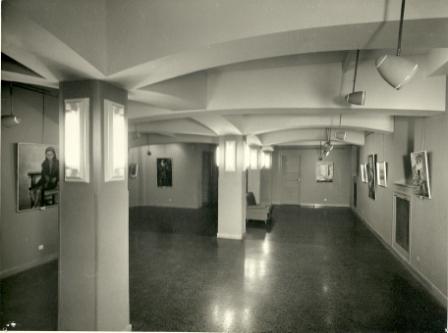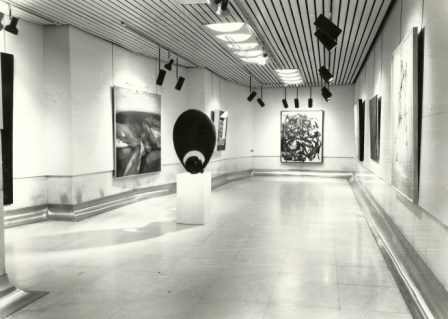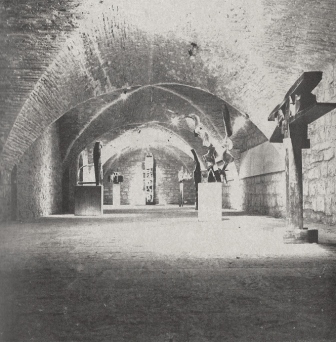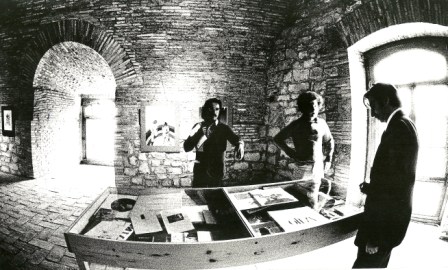25 November
lecture series
training AND sponsorship IN CONTEMPORARY ARTISTS
The promotion of plastic arts in Navarre through the art galleries of the Caja de Ahorros Municipal de Pamplona.
Mr. José María Muruzábal del Solar
Ph.D. in Art History
In 1955, José Mª Muruzábal del Val, my father, working in the Caja de Ahorros Municipal de Pamplona, was commissioned by his director, the remembered Miguel Javier Urmeneta, to set up an exhibition conference room in the premises of the institution. Urmeneta, an important figure in Pamplona society at the time, made great efforts, from the social and cultural work of the CAMP, in favor of social attendance , art and culture. And in this line, in the provincial capital of Pamplona in the fifties, the exhibition conference room was opened on García Castañón Street, in a semi-basement that was refurbished for this purpose. One of the great Spanish artists of the time, Benjamín Palencia, was present at the inauguration. It is now the sixtieth anniversary of this initiative. And this conference room would later be followed by those of Conde Rodezno, Avenida Bayona, Tudela and the Mixed and Oven Pavilions of the Pamplona Citadel.
For many years, García Castañón's conference room was an authentic social and cultural phenomenon of the first magnitude in Pamplona. It was the only exhibition conference room that operated on a regular and continuous basis. It was a strategic place of passage, which encouraged people to enter to see the current exhibition . The inaugurations starring the masters of Navarrese art of the time, such as Jesús Basiano, Lasterra and Ascunce, Eslava and Muñoz Sola, Francis Bartolozzi and Lozano de Sotés, Echauri and Manterola, Martín Caro and Salaberri, etc. constituted a major social and civic event. The Navarrese newspapers devoted entire pages to these events, specialized art criticism was also being developed and the crowds thronged the conference room. As if that were not enough, the sales of these authors were exceptional and, in many cases, constituted practically 100% of the work exhibited. In that facet, traditional landscape painting, dedicated to representing and interpreting the varied lands of the Old Kingdom, was the most sought after and in demand.
García Castañón's inauguration took place in November 1955, with a exhibition of paintings by Benjamín Palencia, then an acclaimed master of Spanish painting. Twenty oil paintings were shown in the aforementioned exhibition and it was an exceptional event in Pamplona at the time, with a carefully curated Catalog. It was estimated that some 15,000 people from Pamplona visited the exhibition, in a Pamplona of barely 80,000 inhabitants. One of the exhibited works was even sold for the very important sum of 20,000 pesetas. The Pamplona press of the time gave ample information of this inauguration and of various events organized around it. In 1955, in addition to Benjamín Palencia, the Navarrese artists Jesús Lasterra, the young apprentice, and Jesús Basiano, the already consecrated master, exhibited there in two exhibitions that will also be remembered in the history of 20th century Navarrese painting.

conference room of García Castañón's exhibitions. The 60's

exhibition of contemporary art masters in the conference room of García Castañón, January 1981.
Years later, another important cultural event took place for the CAMP and for the art world of Navarre. We are talking about the inauguration of the Pavilions and the Oven of the Citadel of Pamplona, in October 1973. For the inauguration of the Citadel, the great Basque sculptor Néstor Basterretxea was present. The exhibition space located there turned out to be an exceptional complement to the traditional conference room of García Castañón. A larger space, its spaciousness and spectacular nature, its stone vaults, attracted another subject of much more avant-garde art than what was usually shown at García Castañón. And there, the presence of non-figurative art, of more advanced artistic currents and also of sculptural works, starting with the great artists of the so-called Basque school, was very common and reiterated.

exhibition by Néstor Basterretxea in the Mixed Pavilion of the Citadel, 1973.
The cultural work carried out by CAMP in the promotion of art, especially art and artists from Navarre, was enormous. In the first thirty years of operation of the CAMP's art galleries, between 1955 and 1984, a total of 744 exhibitions were held in five different galleries: García Castañón - Conde Rodezno - Pabellones and Horno de Ciudadela - Avda. Bayona - Tudela, with an average of almost 25 exhibitions per year. García Castañón's conference room paid special attention to Navarrese artists; the most important Navarrese painters of the second half of the 20th century passed through it, as well as other less important Navarrese artists. It is evident that this conference room promoted and protected, in particular, local art. But the views of the cultural managers of the savings bank were soon widened and, together with local art, the most acclaimed national art appeared. It is a kind of cultural and artistic journey, starting from the local to take steps towards the global. Urmeneta and Muruzábal soon understood that they could not limit themselves to what was merely Pamplona or Navarre and that it was good to open frontiers, forms and styles. With these parameters, García Castañón's conference room , along with the names of Navarre's painting and sculpture, was paraded by the leading figures of Spanish art of the time. These great artists, Barjola, Regoyos, group El Paso, etc. were an enormous cultural incentive for our Community. For the first time in Pamplona it was possible attend to attend exhibitions of national rank, with an extraordinary level for a community of the size and importance that Pamplona had.

exhibition Arranz Bravo and Bartolozzi
Citadel, 1975
